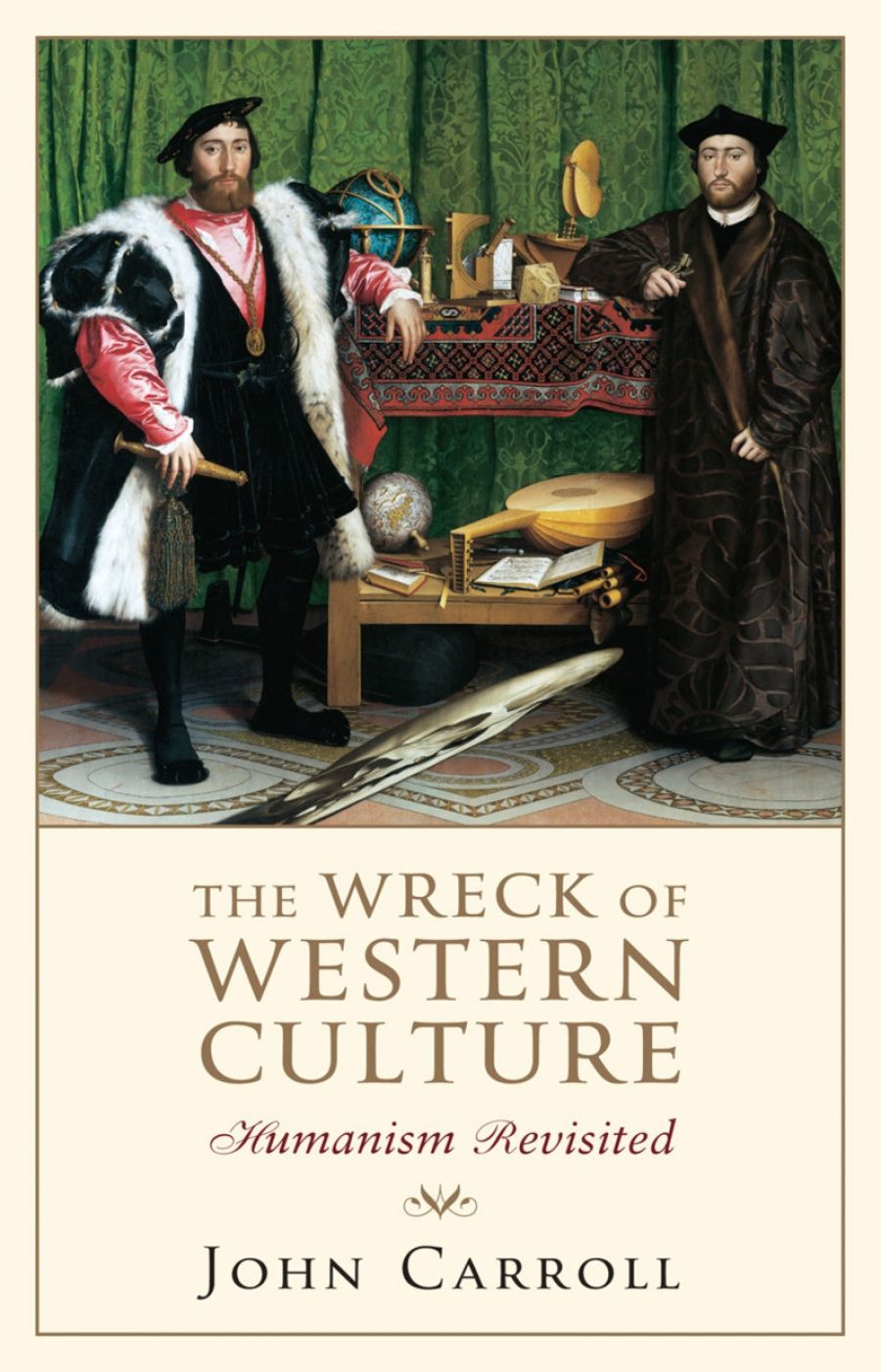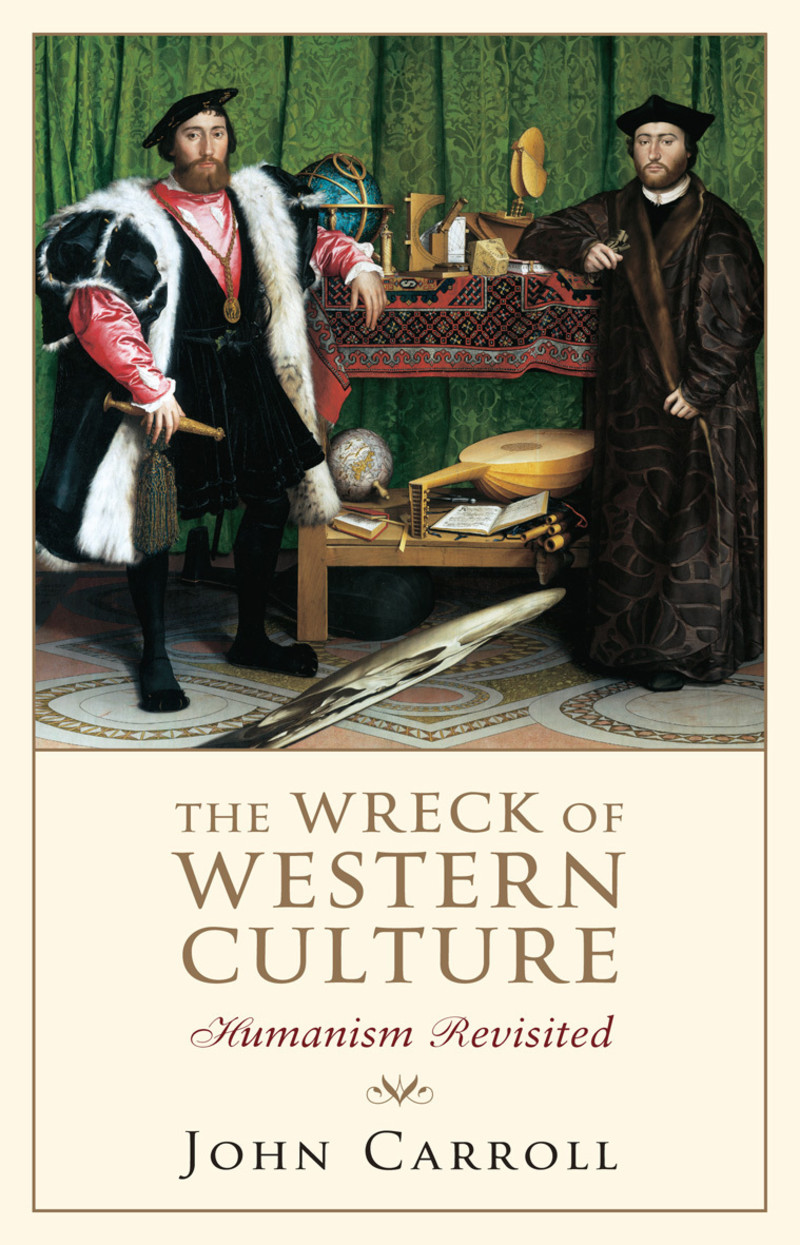
- Free Article: No
- Contents Category: Philosophy
- Review Article: Yes
- Article Title: Maverick Conservative
- Online Only: No
- Custom Highlight Text:
His handsome and expanded edition of John Carroll’s Humanism (1993) is given added weight by an epilogue about the meaning of September 11. It can now be read alongside his recent The Western Dreaming (2001), which tried to chart a way out of the spiritual atrophy of late modernity in which, as this book argues, the unfolding of humanism from the Renaissance on has left us – with its egoistic individualism, its rationalistic blindness to limits and its rancorous hostility to the sacred.
- Book 1 Title: The Wreck of Western Culture
- Book 1 Subtitle: Humanism revisited
- Book 1 Biblio: Scribe, $35 pb, 233 pp
- Book 1 Cover Small (400 x 600):

- Book 1 Cover (800 x 1200):

All stories mix blindness and insight, Carroll’s more starkly than most. The key here is his conception of humanism, which conflates Renaissance classical humanism with the sceptical humanism of the Enlightenment. This simplification casts his history into a philosophical drama in which religious faith fights increasingly beleaguered rearguard actions against a human-centred surrogate that promises progress but ends in nihilism. But Renaissance humanism had more in common with religion than with Enlightened secularism. Its claim of superiority to medieval scholasticism was to inspire men to virtue through the eloquence of literature rather than proving with logic how they ought to be good. Its ‘Reason’ was not Cartesian doubt or Baconian empiricism but a Neoplatonic contemplative apprehension of the beauty of form. Some of its post-Enlightenment successors did hope, hubristically, that literature without religion could provide a rock on which to stand (Carroll’s favourite metaphor). It’s ironic that Carroll should blur literary humanism with the very force that produced, in twentieth-century literary studies, the ‘hermeneutics of suspicion’ that would virtually destroy it.
The dramatic simplicity of Carroll’s ‘grand narrative’ is thus misleading. There is a gulf between Erasmus’s trust in humanity’s free will to act morally, or Pico’s optimism in the capacity to shape the self through self-cultivation – both seen as God-given gifts – and Condorcet’s revolutionary fantasies about human perfectibility or the potential nihilism and megalomania of a Raskolnikov, convinced that with God’s death anything is permitted. Dostoevsky’s sense that Sonya’s ‘almost insatiable compassion’ is tied to her devoutness, and that a purely secular compassion is all too satiable, would be a better point to source a history of present-day crises.
Yet one wouldn’t want to shorten Carroll’s historical narrative. Told through ‘masterpieces’, it moves engagingly from philosophical text to literary works to detailed analyses of paintings and sculptures. Nevertheless, his conceptual confusion makes for a very idiosyncratic canon. ‘The rare masterpieces of culture,’ he argues, ‘are so because they have tapped the deepest truths of their time.’ This means suitability to a role in Carroll’s tale, leaving a two-tier canon: works that get a guernsey as witnesses to humanism’s hollow triumph; and those that express resistance to this. The former are a B side: when Shakespeare is called ‘the greatest of all humanists’, it is a double-edged compliment that implicitly ranks him below A-team film-maker John Ford.
Likewise, selection among oeuvres and the interpretation of selected works are straitjacketed by grand narrative requirements. Shakespeare equals Julius Caesar and Hamlet: the former to present Brutus as a forbear of Dostoevskian moral violators; the latter to set up a sly parallel with today’s therapy-obsessed introversion and (falsely) to identify Hamlet’s morbidity with his humanistic education. (This introduces Carroll’s other charge – challenging but contestable – that humanism can never achieve ‘the death of death’.) Likewise, Henry James equals The Ambassadors, whose hero finally rejects the humanistic cultivation of Paris, rather than The Portrait of a Lady, where the heroine’s tragedy is to allow her aesthetic mentor to petrify her development into refined conventionality.
Such a fate will never befall John Carroll, who can refer to Monet’s ‘wallpaper effeteness’ (he’s better on faces and form than on colour). A less endearing travesty is his dubbing Las Meninas a work of humanist egoistic individualism, despite sensitively noting the infanta’s expression; or his harnessing of a good evocation of Manet’s Olympia to a thesis-serving view of Manet’s intentions, which were not rancorously to mock the Old Masters but the glorified pin-ups of their academic successors. Carroll unfortunately refuses any positive dialectical role to demystifying critique.
However we see the past, we shouldn’t duck Carroll’s challenge to the present. Is the idealistic utilitarianism of a Peter Singer enough, guided by human compassion and a common sense undimmed by political correctness or post-September 11 paranoia? Can literary humanists still claim that, whilst God may be dead, the words of the literary canon are still there on the page, though how many still have the will or the ability to read them? The difficulty of saying yes to such questions confirms the relevance of Carroll’s diagnosis, whatever its inaccuracies. And if there are problems with the remedy he proposes in The Western Dreaming – a renewed attentiveness to the energising myths of our own culture – his achievement is to make one feel the need for us to come up with something better.


Comments powered by CComment